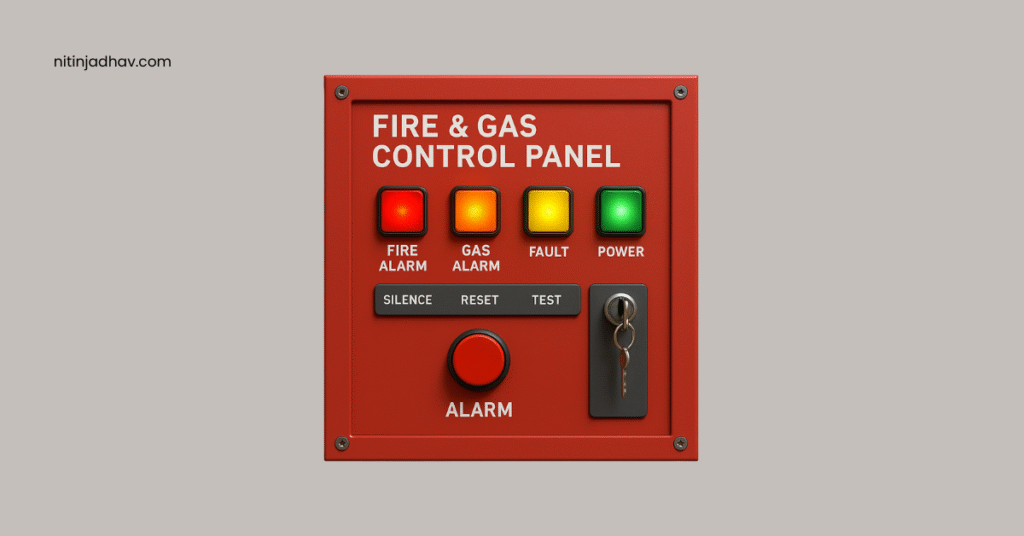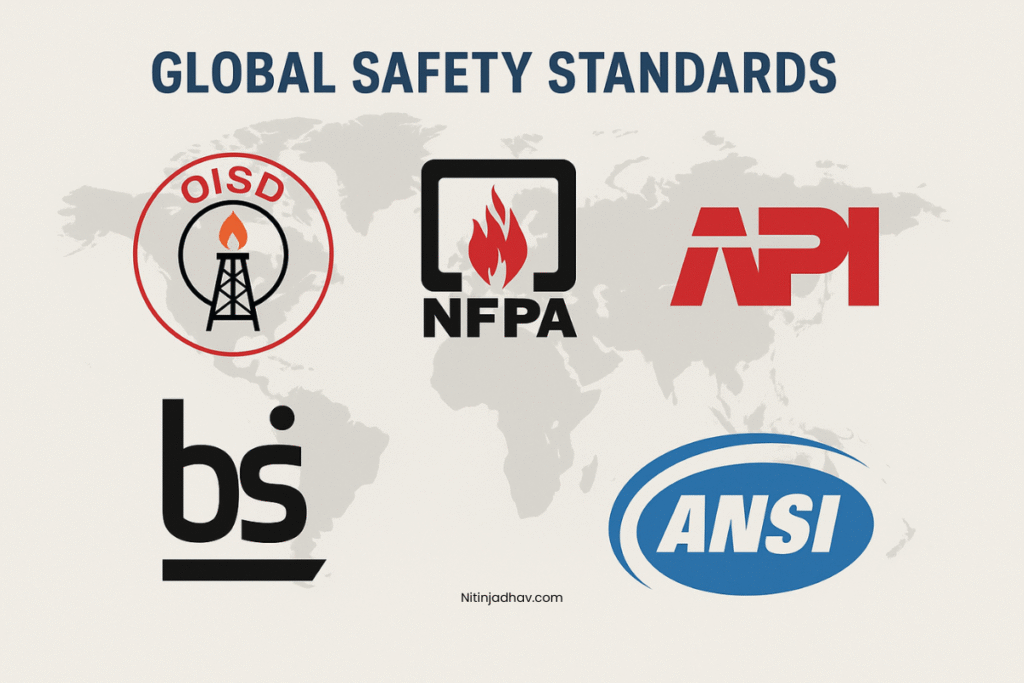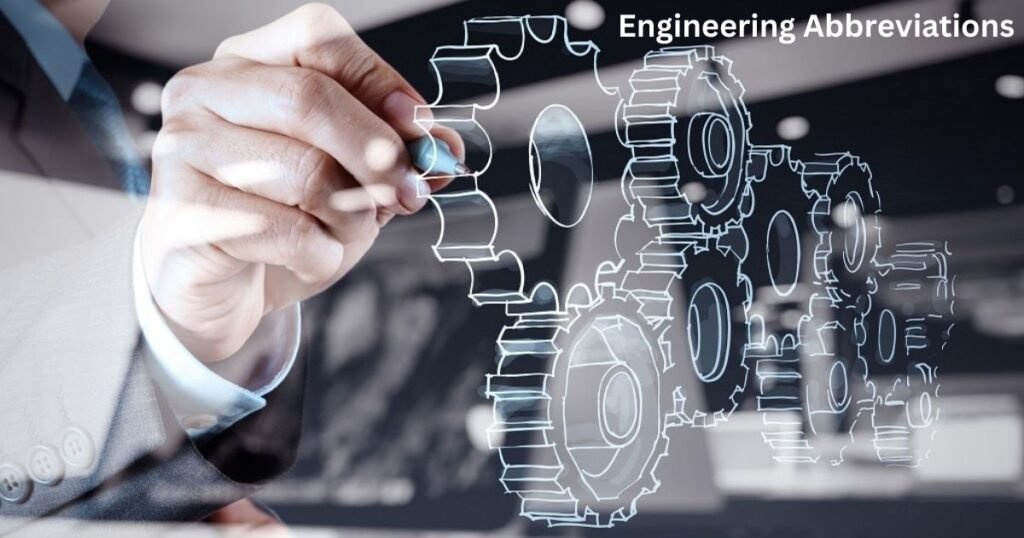🔍 Introduction
In process industries like oil & gas, petrochemical, fertilizers, and power generation, the presence of flammable gases, toxic substances, and potential ignition sources creates a high-risk environment. Even a minor gas leak or fire incident can result in catastrophic loss of life, environmental damage, asset destruction, and business interruption.
To mitigate such risks, a Fire and Gas (F&G) Detection System is implemented. This system forms a critical layer of protection within the overall Process Safety Management (PSM) framework. It provides early detection, activates alarms, and triggers safety actions that help in prompt evacuation and response.
This article provides a comprehensive understanding of Fire and Gas Detection Philosophy – its purpose, components, standards, engineering approach, and real-world application – tailored for engineers involved in FEED, detailed design, operations, and safety audits.
📌 What is Fire and Gas Detection Philosophy?
The Fire and Gas Detection Philosophy is a design basis document that describes:
- The objectives of F&G detection
- The type and location of detectors
- Alarm logic and response actions
- System integration with ESD, DCS, firewater, PA/GA, HVAC, etc.
- Design criteria, codes, and standards
It acts as a guiding framework during project engineering, procurement, and construction, ensuring all safety aspects related to fire and gas events are addressed.
🏋️ Objectives of Fire and Gas Detection Systems
- Early Detection of flammable, toxic, or combustible gases and fire.
- Initiation of alarms (audible/visual) to warn personnel.
- Automatic activation of mitigation systems (e.g., deluge, isolation valves).
- Shutdown or blowdown of critical equipment or entire unit.
- Support for safe evacuation and emergency response planning.
- Compliance with industry standards like OISD, NFPA, API, CCPS, and company-specific guidelines.
🤹 Components of a Fire & Gas System
✅ Detection Devices
| Type | Devices |
|---|---|
| Flammable Gas | Catalytic bead, IR sensors |
| Toxic Gas | Electrochemical, MOS sensors |
| Flame | UV, IR, UV/IR, Visual Flame Detectors |
| Smoke | Optical, Ionization |
| Heat | Fixed temperature, rate-of-rise |
⚖️ Alarm and Control Devices
- Hooters and beacons
- Fire and gas control panel
- Integration with PLC, DCS, or ESD
- Hardwired signals or serial communication protocols (Modbus, HART, PROFIBUS)
🔢 Engineering Design Philosophy
1. Gas Detector Placement
- Based on leak frequency analysis, CFD modeling, and empirical methods
- Placed near potential leak sources: valves, flanges, pumps, compressors
- For heavier-than-air gases (e.g., propane), place near ground; for lighter-than-air (e.g., H2), place high
2. Flame Detector Placement
- Line-of-sight positioning to cover open hydrocarbon processing areas
- Must avoid blind spots due to structures
- Use overlapping cones of vision for redundancy
3. Smoke/Heat Detectors
- Used in enclosed spaces like control rooms, switchgear rooms, HVAC ducts
- Conform to NFPA-72 or local codes
📝 Detector Coverage and Spacing Guidelines
| Area | Detector Type | Placement Notes |
| LPG Spheres | UV/IR + LEL | Perimeter + base mount |
| Pipe Racks | LEL | Every 10m typical |
| Compressor House | LEL + Flame | High leakage probability |
| Substation | Smoke + Heat | For electrical fire risk |
| Control Room | Smoke | Sensitive environment |
Note: Detector coverage is confirmed through F&G Mapping Study and sometimes validated by CFD simulations.
🔬 Voting Logic and Redundancy
To improve system reliability and reduce false alarms:
- 1oo1: Fast response, but prone to nuisance trips
- 2oo3: High availability; preferred for critical functions
- 1oo2, 2oo2: Used where compromise is needed between speed and reliability
These logics are applied in:
- Alarm generation
- ESD system triggering
- Firewater deluge initiation
📊 Integration with Other Safety Systems
F&G systems are not standalone – they interface with:
- Emergency Shutdown System (ESD)
- Deluge and foam systems
- Blowdown system
- HVAC shutdown
- Public Address/General Alarm (PA/GA)
- Firewater pump auto start
📖 Applicable Standards and Guidelines
- OISD-116: Fire Protection Facilities
- NFPA 72: National Fire Alarm and Signaling Code
- API RP 551: Process Measurement Instrumentation
- ISA TR84.00.07: Guidelines for Fire & Gas System Design
- IEC 61508/61511: Functional Safety (for SIL assessments)
- Company specifications (e.g., ADNOC, Saudi Aramco, ONGC standards)
🔗 Related Engineering Studies
- HAZOP: Identifies deviations leading to fire/gas events
- QRA: Quantifies consequences and frequency of such events
- F&G Mapping: Determines detector effectiveness
- SIL Study / LOPA: Determines required Safety Integrity Level
Explore: Complete List of Process Safety Studies
🖊 Real-World Implementation Example
Project: Gas Processing Plant in Middle East
Risk Identified: High probability of H2S gas leak in compressor area
Solution:
- Installed 6 H2S detectors in area
- Integrated with ESD logic using 2oo3 voting
- PA/GA system triggered with evacuation instructions
- Deluge system auto-initiated in case of flame confirmation
Outcome: Passed SIL validation and ensured compliance with client standards
✅ Summary
The Fire and Gas Detection Philosophy is not just a document – it is a life-saving strategy. A well-designed F&G system ensures that hazards are detected early, responded to automatically, and mitigated effectively.
For engineers, understanding the basics of F&G systems is crucial not only for project safety but also for ensuring compliance, optimizing cost, and enhancing reliability.


